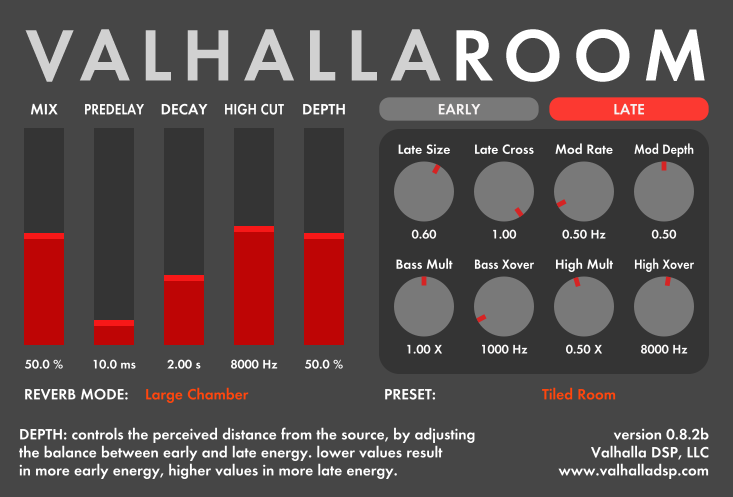Subtotal: $50 USD
Upcoming Plugin: ValhallaRoom
Things have been pretty quiet for the past few months here at The Halls of Valhalla. I’ve been hard at work on my new plugin: ValhallaRoom.
I’ll be talking about this new plugin in length over the next few weeks. A quick summary of what it does:
- ValhallaRoom features several original reverberation algorithms, designed to produce tight and subtle room sounds, as well as larger hall sounds and huge ambiances
- Unique Early reverb section allows user to dial in subtle and short bursts of early reverberation energy, as well as gated reverbs up to 1 second in length.
- The Late section produces natural reverb decays ranging from 0.1 seconds to 100 seconds. The decay can be controlled in 3 adjustable frequency bands.
- Both Early and Late reverb sections have adjustable modulation, to produce sounds ranging from lush chorusing, to subtle and natural long decays.
- ValhallaRoom is true stereo. The Early and Late reverb sections are both stereo-in, stereo-out.
The goal of ValhallaRoom is to be a useful “workhorse” reverb, for subtle drum rooms that can be felt more than heard, lush halls, dense plates, and big ambient decays. The algorithm designs have been influenced by some of the “classic” room simulation boxes, as well as state of the art modern theory.
ValhallaRoom will be released in the next few weeks. Price will be $50 US. I’ll post progress reports to the blog.
 Valhalla Shimmer
Valhalla Shimmer 




Nice! Will it be possible to do inverse reverbs with it? I’m desperately looking for one that doesn’t cost and arm and a leg..
Hi Mateo,
No inverse reverbs currently in there. Gated, yes, but no inverse.
Y’know, let me think about this for a bit. I’ll get back to you about this…
I like the sound of that! thanks
You always have a unique take on signal processing, I can’t wait to hear what you’ve dreamed up in this new verb!!
Thanks, Chuck!
Awe-some!!!
Brilliant UI design! A computer user interface that is not afraid to look like a computer interface. Very glad to see you NOT make it look like fake hardware.
BTW will there be any offer to ValhallaShimmer owners?
I am really looking forward to this. I love Shimmer and I love your GUI aesthetic.
I have a question about Valhallaroom on Mac.
Is it possible to work with Valhallaroom and the OSX screenreader Voiceover?
Here some Informations about Voiceover for Developer:
http://developer.apple.com/library/mac/#documentation/Accessibility/Conceptual/AccessibilityMacOSX/OSXAXIntro/OSXAXintro.html
Regarts
I’ll look into this. I know that I asked the Juce developer about this in the past, and there wasn’t any follow up on his part, so I’ll ping him again. Juce is the SDK that I use for developing my plugins, so Voiceover would probably have to map to something in Juce.
For the not sooo rich users of your plugins – after you finished your surely great work, could you tell a little bit about the differences to EOS (which I use as a kind of “workhorse”, and Valhalla shimmer for special sounds)? I really love both of your reverbs, the audiodamage one and the shimmer, and would love to learn where you’d place your new one.
A quick breakdown of the 3 reverbs:
Once I release ValhallaRoom (or VRoom, as some people started calling it, which makes me happy) there will be demo versions available for audition, so you can hear the differences for yourself.
Many many thanks Sean!
I want to beta test! 😀
Thanks much, mate, for explaining the differences between the 3 reverbs in detail. I was offline for a few weeks (bavaria, near the alps^^) so only discovered it now. Thanks a lot! Looking forward to the windows-version.
A legend was born then.